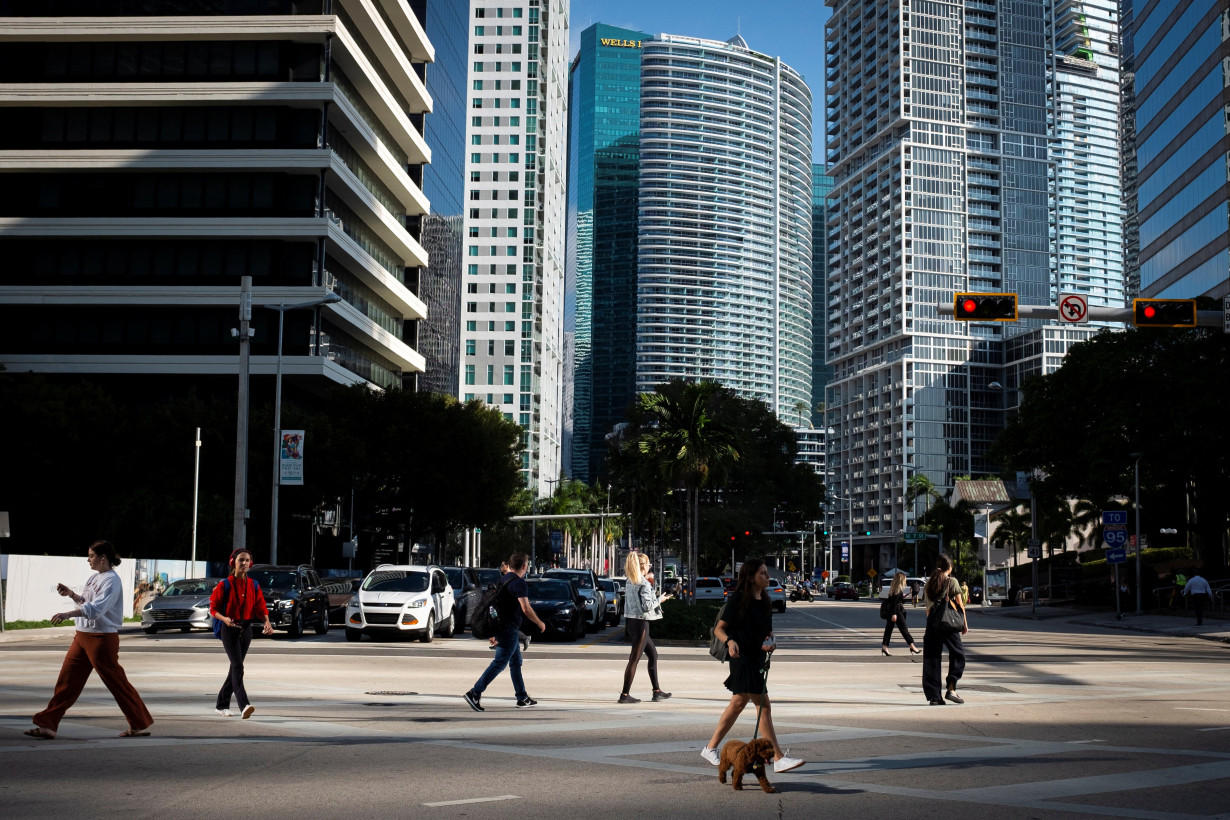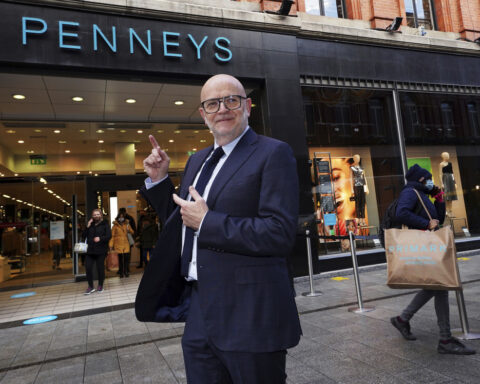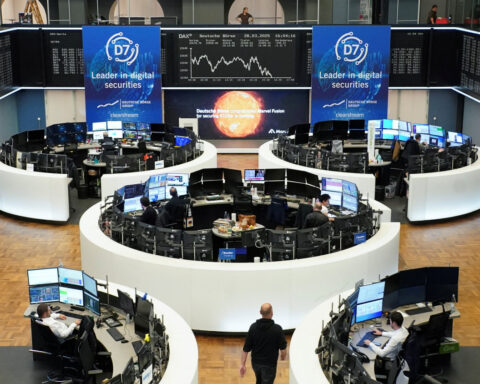By Lucia Mutikani
WASHINGTON (Reuters) -U.S. corporate profits surged to a record high in the fourth quarter amid strong demand and pricing power, but an uncertain economic outlook due to tariffs is creating a challenging environment for businesses that economists say could force companies to lay off workers to protect margins.
The report from the Commerce Department on Thursday also showed the economy grew at a slightly more solid clip last quarter than previously estimated, driven by preemptive buying of big-ticket items like motor vehicles ahead of import duties.

President Donald Trump has announced a blizzard of tariff actions since taking office in January. On Wednesday, Trump unveiled a 25% levy on imported cars and light trucks starting next week. Economists say the manner in which the tariffs are being handled is not supportive of economic activity.
Business and consumer sentiment have sagged. The odds of a recession have risen, with the nation's trade partners also expected to retaliate through duties of their own.
"Profit margins are a leading recession indicator and, at least before the disruptions that will be caused by the tariff hikes, there was no reason to expect a recession in 2025," said Conrad DeQuadros, senior economic advisor at Brean Capital.
Profits from current production with inventory valuation and capital consumption adjustments jumped $204.7 billion, or at a 5.4% rate, to an all-time high of $4 trillion last quarter, the Commerce Department's Bureau of Economic Analysis (BEA) said.
The increase was the largest since the second quarter of 2021 and followed a decline of $15.0 billion in the July-September quarter. The profits of domestic financial firms jumped $69.4 billion while those of non-financial firms rose $53.1 billion. Corporate profits for the rest of the world shot up $82.2 billion.
A measure that is conceptually most similar to S&P 500 profits increased at a 6.7% pace after declining at a 0.3% pace in the July-September period. Overall, profits increased $281.3 billion in 2024 after rising by $229.8 billion in 2023.
Profit margins touched a record high as a share of gross domestic product, suggesting some scope for companies to absorb rising costs from tariffs. But most economists said it was unlikely that companies would willingly do so.
"Most businesses will likely try to pass costs on or cut expenses elsewhere to offset tariff effects," said Shannon Grein, an economist at Wells Fargo.
"The rub is that consumers are highly price-sensitive. While they're also acutely aware of tariffs and may be more willing to take price (increases) initially, they will grow more fatigued over time, denting firms' ability to pass costs continuously."
The Federal Reserve last week left interest rates unchanged, an acknowledgement of the uncertainty swirling around the economy.
Stocks on Wall Street fell in choppy trade. The dollar eased against a basket of currencies. U.S. Treasury yields were mostly higher.
PREEMPTIVE BUYING
Consumers, eager to avoid higher prices from imports, front-loaded purchases of goods last quarter, driving spending and keeping the economic expansion on track.
Gross domestic product increased at an upwardly revised 2.4% annualized rate, the BEA said in its third estimate of fourth-quarter GDP. Growth was previously estimated at a 2.3% pace. The economy grew at a 3.1% rate in the third quarter.
Strong profits boosted an alternative measure of economic growth. Gross domestic income grew at a 4.5% rate after rising at a 1.4% pace in the July-September period.
GDP and GDI generally should be equal, but in practice they differ as they are estimated using different and largely independent source data. Annual benchmark revisions tend to close the gap between GDP and GDI.
The average of GDP and GDI, also referred to as gross domestic output and considered a better measure of economic activity, increased at a 3.5% rate. Gross domestic output grew at a 2.2% pace in the third quarter.
Solid corporate margins are allowing companies to retain workers, supporting the labor market.
A separate report from the Labor Department showed initial claims for state unemployment benefits fell 1,000 to a seasonally adjusted 224,000 for the week ended March 22.
But economic uncertainty is making firms increasingly hesitant to increase hiring, resulting in those who have lost their jobs experiencing difficulties finding new ones.
The number of people receiving benefits after an initial week of aid, a proxy for hiring, decreased 25,000 to a still-elevated seasonally adjusted 1.856 million during the week ending March 15, the claims report showed.
Economists expect the Trump administration's aggressive trade policy and an ambitious campaign to drastically downsize the federal government through deep spending cuts and mass firings to shake labor market stability.
"If corporate profit margins compress because of a sudden weakening in the economy or higher input costs because of tariffs and the inability to pass them onto consumers, it could lay the groundwork for layoffs," said Ryan Sweet, chief U.S. economist at Oxford Economics.
There are signs that GDP growth has significantly slowed in the first quarter because of snowstorms and unseasonably cold weather as well as trade policy uncertainty.
A separate report from the Census Bureau showed the goods trade deficit narrowed 4.9% in February to $147.9 billion, but stayed close to recent record highs. The goods trade deficit deteriorated as companies rushed through imports.
Most of the goods are being quickly snapped up by consumers, instead of accumulating in warehouses, which would normally blunt the impact on GDP. Goldman Sachs cut its first-quarter GDP estimate to a 1.0% rate from the 1.3% pace previously envisioned. The Atlanta Fed is forecasting GDP will contract at a 1.8% rate.
The divergence between the forecasts is due to imports of gold, mostly from Europe, which accounted for much of the recent surge. That inflow is viewed as being related to fears of tariffs on the precious metal.
The BEA excludes most gold imports when calculating the imports component of GDP, Goldman Sachs said.
"While we don't anticipate an outright pullback in activity, we see the odds of a recession in the next 12 months at about 40%," said Lydia Boussour, senior economist at EY-Parthenon.
(Reporting by Lucia Mutikani; Editing by Paul Simao)

 Trump has begun another trade war. Here's a timeline of how we got here
Trump has begun another trade war. Here's a timeline of how we got here
 Canada's leader laments lost friendship with US in town that sheltered stranded Americans after 9/11
Canada's leader laments lost friendship with US in town that sheltered stranded Americans after 9/11
 Chinese EV giant BYD's fourth-quarter profit leaps 73%
Chinese EV giant BYD's fourth-quarter profit leaps 73%
 You're an American in another land? Prepare to talk about the why and how of Trump 2.0
You're an American in another land? Prepare to talk about the why and how of Trump 2.0
 Chalk talk: Star power, top teams and No. 5 seeds headline the women's March Madness Sweet 16
Chalk talk: Star power, top teams and No. 5 seeds headline the women's March Madness Sweet 16
 Purdue returns to Sweet 16 with 76-62 win over McNeese in March Madness
Purdue returns to Sweet 16 with 76-62 win over McNeese in March Madness








